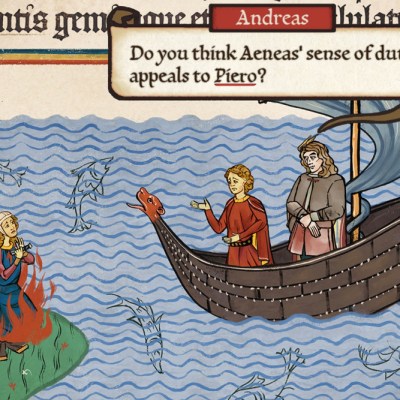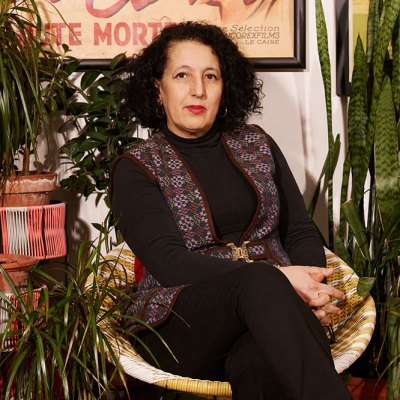The Assassin’s Creed video game series has transported players everywhere from ancient Greece during the Peloponnesian Wars and the Middle East in the Middle Ages to Renaissance Italy and Victorian London. For its latest edition, the game’s developers Ubisoft enlisted four experts in Islamic art and architecture to help depict ninth-century Baghdad, the capital of the Abbasid caliphate. Here Dr Glaire Anderson, senior lecturer in Islamic art at Edinburgh University, discusses her involvement and the educational potential of video games.
Dr Glaire Anderson

How did you come to be involved with this video game?
I’ve known about the Assassin’s Creed series for years and had been following the work that they’ve been doing with museums and academics, which I thought was really the right direction. Because Viking and Islamic encounters are a long-standing research interest of mine, I reached out to them when I noticed what they were doing around Assassin’s Creed Valhalla and the accompanying Discovery Tour game. I wanted to offer any help that might be needed around the medieval Islamic material because it’s a quite a small field, and I figured that they may not have access to many academic experts in that topic. My involvement in Assassin’s Creed Mirage evolved out of that.
What were the key considerations or concerns when you were working on Assassin’s Creed Mirage?
The key point that I wanted to bring to their attention was Baghdad’s lack of monuments and buildings dating from before the 13th century. To me that felt like an important thing that [the designers] would have to grapple with when recreating that specific medieval urban environment, especially as the Assassin’s Creed franchise is known for spending a lot of time and attention on historical authenticity. As someone who had admired what they’d done in earlier games with medieval Venice and Florence, for instance, I felt that representing ninth-century Baghdad was a steep order but a very important and laudable project. I wanted to do what I could as an expert to give them the resources they needed, because I imagined the information wouldn’t be as familiar to artists and designers as, say, Renaissance Italy.
How did you go about providing them with that information?
My work with Ubisoft began with a series of weekly workshops in which my team and I would present to their in-house history team, led by Ubisoft’s world-design director Maxime Durand. I approached these workshops like intensive graduate seminars on art in the age of the caliphs, which is a field of my expertise that I’ve been teaching for nearly two decades now. As part of that, I was showing them architecture, art and [aspects of] urbanism that are specific to the caliphate period and to the Abbasids.
Still from the historical feature on Assassin’s Creed Mirage. Photo: Courtesy of Shangri La Museum; © Assassin’s Creed & Ubisoft Entertainment

You also helped inform the game’s new historical feature, ‘History of Baghdad’. How does having an educational aspect enhance the gaming experience?
I think [the educational aspect] is why Assassin’s Creed has become so popular – even with people who don’t consider themselves gamers. But I also think that gamers are interested in these kinds of histories and that is reflected in the way the public more generally are engaging with history through entertainment. Maxine Durand has said, and I agree, that video games are hugely important as a form of entertainment through which people engage with the past. Many scholars and historians have been arguing this and it’s laudable that Ubisoft have listened to that and responded. In part, I think they have led the way by putting well-researched history into video games while at the same time, of course, creating fantasy worlds.
In terms of my own research as a historian of architecture, landscapes and objects, video game engines have been incredibly useful as a tool for visualisation and trying out different possibilities. It was an important part of my research process for my first book on the villas of early Islamic Spain and for a series of articles that I subsequently published after that.
Do you think that visualisation helps to make such histories more accessible?
I think of it as having an ethical component. There are lots of reasons why people don’t know the history of Islamic art, architecture or societies. Survival of the evidence is one of those reasons – and you can’t think about that without thinking about broader histories of imperialism, colonialism and warfare. We don’t have medieval Baghdad because it was destroyed by the Mongols in the 13th century. It’s much harder for people to connect with that history when you don’t have easily comprehensible remains still standing. I think that the video game as a medium makes it possible for people to understand what we’ve lost and this is so very important – as a way of introducing people to unfamiliar histories, unfamiliar art histories and unfamiliar cultural heritage.
Do you think there’s a potential issue with games romanticising or sensationalising history?
No more or less than any other form of entertainment. I think of it in the same way as film or television. Is there any more of a danger with video games? I don’t think so. It’s something I want to think through more, but I don’t see it as any more problematic.
Still from Assassin’s Creed Mirage. Photo: © Assassin’s Creed & Ubisoft Entertainment

Visualisation aside, has working on the game informed your own research?
Absolutely! My longer research trajectory has been around how we tell more inclusive stories: I’ve published a lot about women in medieval Islamic contexts as patrons of architecture, as well as about other historical figures that haven’t taken centre stage in the stories we tell about Islamic art and history. But I think the experience of working on Mirage really underscored for me how important it is that experts in these topics reach out of the academy and engage with the people who are making forms of entertainment – video games, television, film – that represent the past, because this informs how the public perceive and understand it. If we want an informed public and entertainment that we’re happy to consume, then we, as academics, should be engaging with companies like Ubisoft who are willing to work with us.
From what you’ve seen of the game so far, what do you think of the environment Ubisoft has created?
I have two different reactions depending on what hat I’m wearing at the time. When I look at the game trailer, particularly the aerial views, the individual architectural elements are a bit jarring because I can see that many of them – the Round City aside – are not authentic to the caliphate period, but are actually important references to Islamic architecture far outside the moment in the ninth century that the game is supposedly set in. As a historian, I find that jarring, even if what they’ve done is visually spectacular. I would have conceptualised Baghdad in a way that’s much closer to the archaeological evidence that we have for ninth-century Iraq – but at the same time, I think what they’ve done has a significance that goes beyond that. This is a video game that’s going to bring an unfamiliar artistic tradition and global history to many players and in a way, what they have created is a homage to the entire expanse of Islamic art and architecture. If I don’t look at it from a strictly scholarly perspective, I think it’s very exciting and commendable.
Assassin’s Creed Mirage is out now for PlayStation 4, PlayStation 5, Windows, Xbox One, and Xbox Series X/S.



